Evolutionary Adaptation of Protein Turnover in White Muscle of Stenothermal Antarctic Fish: Elevated Cold Compensation at Reduced Thermal Responsiveness
Abstract
1. Introduction
2. Materials and Methods
2.1. Animals
2.2. Acute Warming Experiment
2.3. Measurement of Protein Synthesis Rate
2.4. Protein Degradation via Measurements of Cathepsin D Activity
2.5. Metabolic Profiling
2.6. Statistical Analyses
3. Results
3.1. Protein Synthesis Rate
3.2. Protein Degradation
3.3. Metabolites
3.3.1. Pachycara brachycephalum
3.3.2. Zoarces viviparus
3.3.3. Comparison between the Antarctic and Common Eelpout
4. Discussion
4.1. Thermal Plasticity of the Cold-Stenothermal Pachycara brachycephalum
4.2. Thermal Response of the Eurythermal Zoarces viviparus
4.3. Comparison between the Antarctic and Common Eelpout
5. Conclusions
Supplementary Materials
Author Contributions
Funding
Institutional Review Board Statement
Informed Consent Statement
Data Availability Statement
Acknowledgments
Conflicts of Interest
References
- Pörtner, H.O. Climate Impacts on Organisms, Ecosystems and Human Societies: Integrating OCLTT into a Wider Context. J. Exp. Biol. 2021, 224, jeb238360. [Google Scholar] [CrossRef] [PubMed]
- Dahlke, F.T.; Wohlrab, S.; Butzin, M.; Pörtner, H.-O. Thermal Bottlenecks in the Life Cycle Define Climate Vulnerability of Fish. Science 2020, 369, 65–70. [Google Scholar] [CrossRef] [PubMed]
- Ern, R.; Andreassen, A.H.; Jutfelt, F. Physiological Mechanisms of Acute Upper Thermal Tolerance in Fish. Physiology 2023, 38, 141–158. [Google Scholar] [CrossRef]
- Pörtner, H.O.; Farrell, A.P. Physiology and Climate Change. Science 2008, 322, 690–692. [Google Scholar] [CrossRef]
- Peck, L.S. Antarctic Marine Biodiversity: Adaptations, Environments and Responses to Change; Taylor & Francis: Oxfordshire, UK, 2018; Volume 56, ISBN 9781138318625. [Google Scholar]
- Peck, L.S. A Cold Limit to Adaptation in the Sea. Trends Ecol. Evol. 2016, 31, 13–26. [Google Scholar] [CrossRef]
- Clarke, A.; Meredith, M.P.; Wallace, M.I.; Brandon, M.A.; Thomas, D.N. Seasonal and Interannual Variability in Temperature, Chlorophyll and Macronutrients in Northern Marguerite Bay, Antarctica. Deep Sea Res. Part II Top. Stud. Oceanogr. 2008, 55, 1988–2006. [Google Scholar] [CrossRef]
- Clarke, A. What Is Cold Adaptation and How Should We Measure It? Integr. Comp. Biol. 1991, 31, 81–92. [Google Scholar] [CrossRef]
- Clarke, A.; Ern, R.; Andreassen, A.H.; Jutfelt, F.; Pörtner, H.O.; Scholes, R.J.; Arneth, A.; Barnes, D.K.A.; Burrows, M.T.; Diamond, S.E.; et al. Growth of Marine Ectotherms Is Regionally Constrained and Asymmetric with Latitude. Trends Ecol. Evol. 2023, 34, 502–509. [Google Scholar] [CrossRef]
- Pörtner, H.O. Climate-Dependent Evolution of Antarctic Ectotherms: An Integrative Analysis. Deep. Res. Part II Top. Stud. Oceanogr. 2006, 53, 1071–1104. [Google Scholar] [CrossRef]
- Pörtner, H.O.; Peck, L.; Somero, G. Thermal Limits and Adaptation in Marine Antarctic Ectotherms: An Integrative View. Philos. Trans. R. Soc. B Biol. Sci. 2007, 362, 2233–2258. [Google Scholar] [CrossRef]
- Brodte, E.; Knust, R.; Pörtner, H.O. Temperature-Dependent Energy Allocation to Growth in Antarctic and Boreal Eelpout (Zoarcidae). Polar Biol. 2006, 30, 95–107. [Google Scholar] [CrossRef]
- Enzor, L.A.; Hunter, E.M.; Place, S.P. The Effects of Elevated Temperature and Ocean Acidification on the Metabolic Pathways of Notothenioid Fish. Conserv. Physiol. 2017, 5, cox019. [Google Scholar] [CrossRef]
- Windisch, H.S.; Frickenhaus, S.; John, U.; Knust, R.; Pörtner, H.-O.; Lucassen, M. Stress Response or Beneficial Temperature Acclimation: Transcriptomic Signatures in Antarctic Fish (Pachycara brachycephalum). Mol. Ecol. 2014, 23, 3469–3482. [Google Scholar] [CrossRef] [PubMed]
- Langenbuch, M.; Bock, C.; Leibfritz, D.; Pörtner, H.O. Effects of Environmental Hypercapnia on Animal Physiology: A 13C NMR Study of Protein Synthesis Rates in the Marine Invertebrate Sipunculus nudus. Comp. Biochem. Physiol. A Mol. Integr. Physiol. 2006, 144, 479–484. [Google Scholar] [CrossRef] [PubMed]
- Wittmann, A.C.; Schröer, M.; Bock, C.; Steeger, H.U.; Paul, R.J.; Pörtner, H.O. Indicators of Oxygen- and Capacity-Limited Thermal Tolerance in the Lugworm Arenicola Marina. Clim. Res. 2008, 37, 227–240. [Google Scholar] [CrossRef]
- Houlihan, D.F.; McMillan, D.N.; Laurent, P. Growth Rates, Protein Synthesis, and Protein Degradation Rates in Rainbow Trout: Effects of Body Size. Physiol. Zool. 1986, 59, 482–493. [Google Scholar] [CrossRef]
- Foster, A.R.; Houlihan, D.F.; Gray, C.; Medale, F.; Fauconneau, B.; Kaushikj, S.J.; Le Bail, P.Y. The Effects of Ovine Growth Hormone on Protein Turnover in Rainbow Trout. Gen. Comp. Endocrinol. 1991, 82, 111–120. [Google Scholar] [CrossRef]
- Fraser, K.P.P.; Peck, L.S.; Clark, M.S.; Clarke, A.; Hill, S.L. Life in the Freezer: Protein Metabolism in Antarctic Fish. R. Soc. Open Sci. 2022, 9, 211272. [Google Scholar] [CrossRef]
- Krebs, N.; Tebben, J.; Bock, C.; Mark, F.C.; Lucassen, M.; Lannig, G.; Pörtner, H. Protein Synthesis Determined from Non-Radioactive Phenylalanine Incorporated by Antarctic Fish. Metabolites 2023, 13, 338. [Google Scholar] [CrossRef]
- Smith, M.A.K.; Haschemeyer, A.E.V. Protein Metabolism and Cold Adaptation in Antarctic Fish. Physiol. Zool. 1980, 53, 373–382. [Google Scholar] [CrossRef]
- McCarthy, I.D.; Moksness, E.; Pavlov, D.A.; Houlihan, D.F. Effects of Water Temperature on Protein Synthesis and Protein Growth in Juvenile Atlantic Wolffish (Anarhichas lupus). Can. J. Fish. Aquat. Sci. 1999, 56, 231–241. [Google Scholar] [CrossRef][Green Version]
- Nemova, N.N.; Lysenko, L.A.; Kantserova, N.P. Degradation of Skeletal Muscle Protein during Growth and Development of Salmonid Fish. Russ. J. Dev. Biol. 2016, 47, 161–172. [Google Scholar] [CrossRef]
- Cassidy, A.A.; Driedzic, W.R.; Campos, D.; Heinrichs-Caldas, W.; Almeida-Val, V.M.F.; Val, A.L.; Lamarre, S.G. Protein Synthesis Is Lowered by 4EBP1 and EIF2-a Signaling While Protein Degradation May Be Maintained in Fasting, Hypoxic Amazonian Cichlids Astronotus Ocellatus. J. Exp. Biol. 2018, 221, jeb167601. [Google Scholar] [CrossRef] [PubMed]
- Martínez-Alarcón, D.; Saborowski, R.; Rojo-Arreola, L.; García-Carreño, F. Is Digestive Cathepsin D the Rule in Decapod Crustaceans? Comp. Biochem. Physiol. Part B Biochem. Mol. Biol. 2018, 215, 31–38. [Google Scholar] [CrossRef] [PubMed]
- Deborde, C.; Hounoum, B.M.; Moing, A.; Maucourt, M.; Jacob, D.; Corraze, G.; Médale, F.; Fauconneau, B. Putative Imbalanced Amino Acid Metabolism in Rainbow Trout Long Term Fed a Plant-Based Diet as Revealed by 1H-NMR Metabolomics. J. Nutr. Sci. 2021, 10, e13. [Google Scholar] [CrossRef]
- Götze, S.; Bock, C.; Eymann, C.; Lannig, G.; Steffen, J.B.M.; Pörtner, H.-O. Single and Combined Effects of the “Deadly Trio” Hypoxia, Hypercapnia and Warming on the Cellular Metabolism of the Great Scallop Pecten Maximus. Comp. Biochem. Physiol. Part B Biochem. Mol. Biol. 2020, 243–244, 110438. [Google Scholar] [CrossRef] [PubMed]
- Rebelein, A.; Pörtner, H.-O.; Bock, C. Untargeted Metabolic Profiling Reveals Distinct Patterns of Thermal Sensitivity in Two Related Notothenioids. Comp. Biochem. Physiol. Part A Mol. Integr. Physiol. 2018, 217, 43–54. [Google Scholar] [CrossRef]
- Windisch, H.S.; Lucassen, M.; Frickenhaus, S. Evolutionary Force in Confamiliar Marine Vertebrates of Different Temperature Realms: Adaptive Trends in Zoarcid Fish Transcriptomes. BMC Genom. 2012, 13, 1–16. [Google Scholar] [CrossRef]
- Anderson, M.E. Systematics and Osteology of the Zoarcidae (Teleostei: Perciformes); Rhodes University: Makhanda, South Africa, 1994. [Google Scholar]
- Lannig, G.; Storch, D.; Pörtner, H.O. Aerobic Mitochondrial Capacities in Antarctic and Temperate Eelpout (Zoarcidae) Subjected to Warm versus Cold Acclimation. Polar Biol. 2005, 28, 575–584. [Google Scholar] [CrossRef]
- Storch, D.; Lannig, G.; Pörtner, H.O. Temperature-Dependent Protein Synthesis Capacities in Antarctic and Temperate (North Sea) Fish (Zoarcidae). J. Exp. Biol. 2005, 208, 2409–2420. [Google Scholar] [CrossRef]
- Brodte, E.; Knust, R.; Pörtner, H.O.; Arntz, W.E. Biology of the Antarctic Eelpout Pachycara Brachycephalum. Deep. Res. Part II Top. Stud. Oceanogr. 2006, 53, 1131–1140. [Google Scholar] [CrossRef]
- Gon, O.; Heemstra, P.C. (Eds.) Fishes of the Southern Ocean; South African Institute for Aquatic Biodiversity: Makhanda, South Africa, 1990; 462p. [Google Scholar]
- Lannig, G.; Tillmann, A.; Howald, S.; Stapp, L.S. Thermal Sensitivity of Cell Metabolism of Different Antarctic Fish Species Mirrors Organism Temperature Tolerance. Polar Biol. 2020, 43, 1887–1898. [Google Scholar] [CrossRef]
- Mark, F.C.; Bock, C.; Pörtner, H.O. Oxygen-Limited Thermal Tolerance in Antarctic Fish Investigated by MRI and 31P-MRS. Am. J. Physiol. Regul. Integr. Comp. Physiol. 2002, 283, 1254–1262. [Google Scholar] [CrossRef][Green Version]
- Van Dijk, P.L.M.; Tesch, C.; Hardewig, I.; Pörtner, H.O. Physiological Disturbances at Critically High Temperatures: A Comparison between Stenothermal Antarctic and Eurythermal Temperate Eelpouts (Zoarcidae). J. Exp. Biol. 1999, 202, 3611–3621. [Google Scholar] [CrossRef] [PubMed]
- Zakhartsev, M.V.; De Wachter, B.; Sartoris, F.J.; Pörtner, H.O.; Blust, R. Thermal Physiology of the Common Eelpout (Zoarces viviparus). J. Comp. Physiol. B Biochem. Syst. Environ. Physiol. 2003, 173, 365–378. [Google Scholar] [CrossRef]
- Pörtner, H.O.; Knust, R. Climate Change Affects Marine Fishes Through the Oxygen Limitation of Thermal Tolerance. Science 2007, 315, 920–921. [Google Scholar] [CrossRef]
- Fonds, M.; Jaworski, A.; Iedema, A.; Puyl, P.V.D. Metabolsim, Food Consumption, Growth and Food Conversion of Shorthorn Sculpin (Myoxocephalus scorpius) and Eelpout (Zoarces viviparus). J. Chem. Inf. Model. 1989, 53, 1689–1699. [Google Scholar]
- Fonds, M.; Cronie, R.; Vethaak, A.D.; Van Der Puyl, P. Metabolism, Food Consumption and Growth of Plaice (Pleuronectes platessa) and Flounder (Platichthys flesus) in Relation to Fish Size and Temperature. Neth. J. Sea Res. 1992, 29, 127–143. [Google Scholar] [CrossRef]
- Fly, E.K.; Hilbish, T.J. Physiological Energetics and Biogeographic Range Limits of Three Congeneric Mussel Species. Oecologia 2013, 172, 35–46. [Google Scholar] [CrossRef]
- Gräns, A.; Jutfelt, F.; Sandblom, E.; Jönsson, E.; Wiklander, K.; Seth, H.; Olsson, C.; Dupont, S.; Ortega-Martinez, O.; Einarsdottir, I.; et al. Aerobic Scope Fails to Explain the Detrimental Effects on Growth Resulting from Warming and Elevated CO2 in Atlantic Halibut. J. Exp. Biol. 2014, 217, 711–717. [Google Scholar] [CrossRef]
- Pörtner, H.-O.; Bock, C.; Mark, F.C. Oxygen- and Capacity-Limited Thermal Tolerance: Bridging Ecology and Physiology. J. Exp. Biol. 2017, 220, 2685–2696. [Google Scholar] [CrossRef]
- Barton, S.; Yvon-Durocher, G. Quantifying the Temperature Dependence of Growth Rate in Marine Phytoplankton within and across Species. Limnol. Oceanogr. 2019, 64, 2081–2091. [Google Scholar] [CrossRef]
- Garlick, P.J.; McNurlan, M.A.; Preedy, V.R. A Rapid and Convenient Technique for Measuring the Rate of Protein Synthesis in Tissues by Injection of [3H]Phenylalanine. Biochem. J. 1980, 192, 719–723. [Google Scholar] [CrossRef] [PubMed]
- Bradford, M.M. A Rapid and Sensitive Method for the Quantitation of Microgram Quantities of Protein Utilizing the Principle of Protein-Dye Binding. Anal. Biochem. 1976, 72, 248–254. [Google Scholar] [CrossRef]
- Tripp-Valdez, M.A.; Bock, C.; Lucassen, M.; Lluch-Cota, S.E.; Sicard, M.T.; Lannig, G.; Pörtner, H.O. Metabolic Response and Thermal Tolerance of Green Abalone Juveniles (Haliotis Fulgens: Gastropoda) under Acute Hypoxia and Hypercapnia. J. Exp. Mar. Bio. Ecol. 2017, 497, 11–18. [Google Scholar] [CrossRef]
- Schmidt, M.; Windisch, H.S.; Ludwichowski, K.U.; Seegert, S.L.L.; Pörtner, H.O.; Storch, D.; Bock, C. Differences in Neurochemical Profiles of Two Gadid Species under Ocean Warming and Acidification. Front. Zool. 2017, 14, 1–13. [Google Scholar] [CrossRef]
- Pang, Z.; Zhou, G.; Ewald, J.; Chang, L.; Hacariz, O.; Basu, N.; Xia, J. Using MetaboAnalyst 5.0 for LC–HRMS Spectra Processing, Multi-Omics Integration and Covariate Adjustment of Global Metabolomics Data. Nat. Protoc. 2022, 17, 1735–1761. [Google Scholar] [CrossRef] [PubMed]
- Tusher, V.G.; Tibshirani, R.; Chu, G. Significance Analysis of Microarrays Applied to the Ionizing Radiation Response. Proc. Natl. Acad. Sci. USA 2001, 98, 5116–5121. [Google Scholar] [CrossRef] [PubMed]
- Hosie, G.W.; Fukuchi, M.; Kawaguchi, S. Development of the Southern Ocean Continuous Plankton Recorder Survey. Prog. Oceanogr. 2003, 57, 263–283. [Google Scholar] [CrossRef]
- Mijanovic, O.; Petushkova, A.I.; Brankovic, A.; Turk, B.; Solovieva, A.B.; Nikitina, A.I.; Bolevich, S.; Timashev, P.S.; Parodi, A.; Zamyatnin, A.A. Cathepsin D—Managing the Delicate Balance. Pharmaceutics 2021, 13, 837. [Google Scholar] [CrossRef]
- Zaidi, N.; Maurer, A.; Nieke, S.; Kalbacher, H. Cathepsin D: A Cellular Roadmap. Biochem. Biophys. Res. Commun. 2008, 376, 5–9. [Google Scholar] [CrossRef]
- Muona, M.; Virtanen, E. Effect of Dimethylglycine and Trimethylglycine (Betaine) on the Response of Atlantic Salmon (Salmo salar L.) Smolts to Experimental Vibrio Anguillarum Infection. Fish Shellfish Immunol. 1993, 3, 439–449. [Google Scholar] [CrossRef]
- Bai, K.; Xu, W.; Zhang, J.; Kou, T.; Niu, Y.; Wan, X.; Zhang, L.; Wang, C.; Wang, T. Assessment of Free Radical Scavenging Activity of Dimethylglycine Sodium Salt and Its Role in Providing Protection against Lipopolysaccharide-Induced Oxidative Stress in Mice. PLoS ONE 2016, 11, e0155393. [Google Scholar] [CrossRef]
- Gibb, A.J. Choline and Acetylcholine: What a Difference an Acetate Makes! J. Physiol. 2017, 595, 1021–1022. [Google Scholar] [CrossRef]
- Pörtner, H.O. Physiological Basis of Temperature-Dependent Biogeography: Trade-Offs in Muscle Design and Performance in Polar Ectotherms. J. Exp. Biol. 2002, 205, 2217–2230. [Google Scholar] [CrossRef]
- Moretti, A.; Paoletta, M.; Liguori, S.; Bertone, M.; Toro, G.; Iolascon, G. Choline: An Essential Nutrient for Skeletal Muscle. Nutrients 2020, 12, 2144. [Google Scholar] [CrossRef] [PubMed]
- Jiang, M.; Chavarria, T.E.; Yuan, B.; Lodish, H.F.; Huang, N.J. Phosphocholine Accumulation and PHOSPHO1 Depletion Promote Adipose Tissue Thermogenesis. Proc. Natl. Acad. Sci. USA 2020, 117, 15055–15065. [Google Scholar] [CrossRef]
- Williams, C.M.; Watanabe, M.; Guarracino, M.R.; Ferraro, M.B.; Edison, A.S.; Morgan, T.J.; Boroujerdi, A.F.B.; Hahn, D.A. Cold Adaptation Shapes the Robustness of Metabolic Networks in Drosophila Melanogaster. Evolution 2014, 68, 3505–3523. [Google Scholar] [CrossRef]
- Brodte, E.; Graeve, M.; Jacob, U.; Knust, R.; Pörtner, H.O. Temperature-Dependent Lipid Levels and Components in Polar and Temperate Eelpout (Zoarcidae). Fish Physiol. Biochem. 2008, 34, 261–274. [Google Scholar] [CrossRef]
- Chen, F.; Elgaher, W.A.M.; Winterhoff, M.; Büssow, K.; Waqas, F.H.; Graner, E.; Pires-Afonso, Y.; Casares Perez, L.; de la Vega, L.; Sahini, N.; et al. Citraconate Inhibits ACOD1 (IRG1) Catalysis, Reduces Interferon Responses and Oxidative Stress, and Modulates Inflammation and Cell Metabolism. Nat. Metab. 2022, 4, 534–546. [Google Scholar] [CrossRef]
- Brosnan, J.T. Interorgan Amino Acid Transport and Its Regulation. J. Nutr. 2003, 133, 2068S–2072S. [Google Scholar] [CrossRef] [PubMed]
- Mommsen, T.P.; French, C.J.; Hochachka, P.W. Sites and Patterns of Protein and Amino Acid Utilization during the Spawning Migration of Salmon. Can. J. Zool. 1980, 58, 1785–1799. [Google Scholar] [CrossRef]
- Kiessling, A.; Larsson, L.; Kiessling, K.H.; Lutes, P.B.; Storebakken, T.; Hung, S.S.S. Spawning Induces a Shift in Energy Metabolism from Glucose to Lipid in Rainbow Trout White Muscle. Fish Physiol. Biochem. 1995, 14, 439–448. [Google Scholar] [CrossRef]
- Buckley, B.A.; Gracey, A.Y.; Somero, G.N. The Cellular Response to Heat Stress in the Goby Gillichthys Mirabilis: A CDNA Microarray and Protein-Level Analysis. J. Exp. Biol. 2006, 209, 2660–2677. [Google Scholar] [CrossRef] [PubMed]
- Li, P.; Mai, K.; Trushenski, J.; Wu, G. New Developments in Fish Amino Acid Nutrition: Towards Functional and Environmentally Oriented Aquafeeds. Amino Acids 2009, 37, 43–53. [Google Scholar] [CrossRef]
- Owen, O.E.; Kalhan, S.C.; Hanson, R.W. The Key Role of Anaplerosis and Cataplerosis for Citric Acid Cycle Function. J. Biol. Chem. 2002, 277, 30409–30412. [Google Scholar] [CrossRef]
- Mommsen, T.P. Paradigms of Growth in Fish. Comp. Biochem. Physiol. B Biochem. Mol. Biol. 2001, 129, 207–219. [Google Scholar] [CrossRef]
- Fields, P.A.; Dong, Y.; Meng, X.; Somero, G.N. Adaptations of Protein Structure and Function to Temperature: There Is More than One Way to ‘Skin a Cat’. J. Exp. Biol. 2015, 218, 1801–1811. [Google Scholar] [CrossRef]
- Feller, G. Protein Stability and Enzyme Activity at Extreme Biological Temperatures. J. Phys. Condens. Matter 2010, 22, 323101. [Google Scholar] [CrossRef]
- Todgham, A.E.; Hoaglund, E.A.; Hofmann, G.E. Is Cold the New Hot? Elevated Ubiquitin-Conjugated Protein Levels in Tissues of Antarctic Fish as Evidence for Cold-Denaturation of Proteins in Vivo. J. Comp. Physiol. B Biochem. Syst. Environ. Physiol. 2007, 177, 857–866. [Google Scholar] [CrossRef]
- Treberg, J.R.; Driedzic, W.R. Elevated Levels of Trimethylamine Oxide in Deep-Sea Fish: Evidence for Synthesis and Intertissue Physiological Importance. J. Exp. Zool. 2002, 293, 39–45. [Google Scholar] [CrossRef] [PubMed]
- Fraser, K.P.P.; Rogers, A.D. Protein Metabolism in Marine Animals: The Underlying Mechanism of Growth. Adv. Mar. Biol. 2007, 52, 267–362. [Google Scholar] [CrossRef] [PubMed]
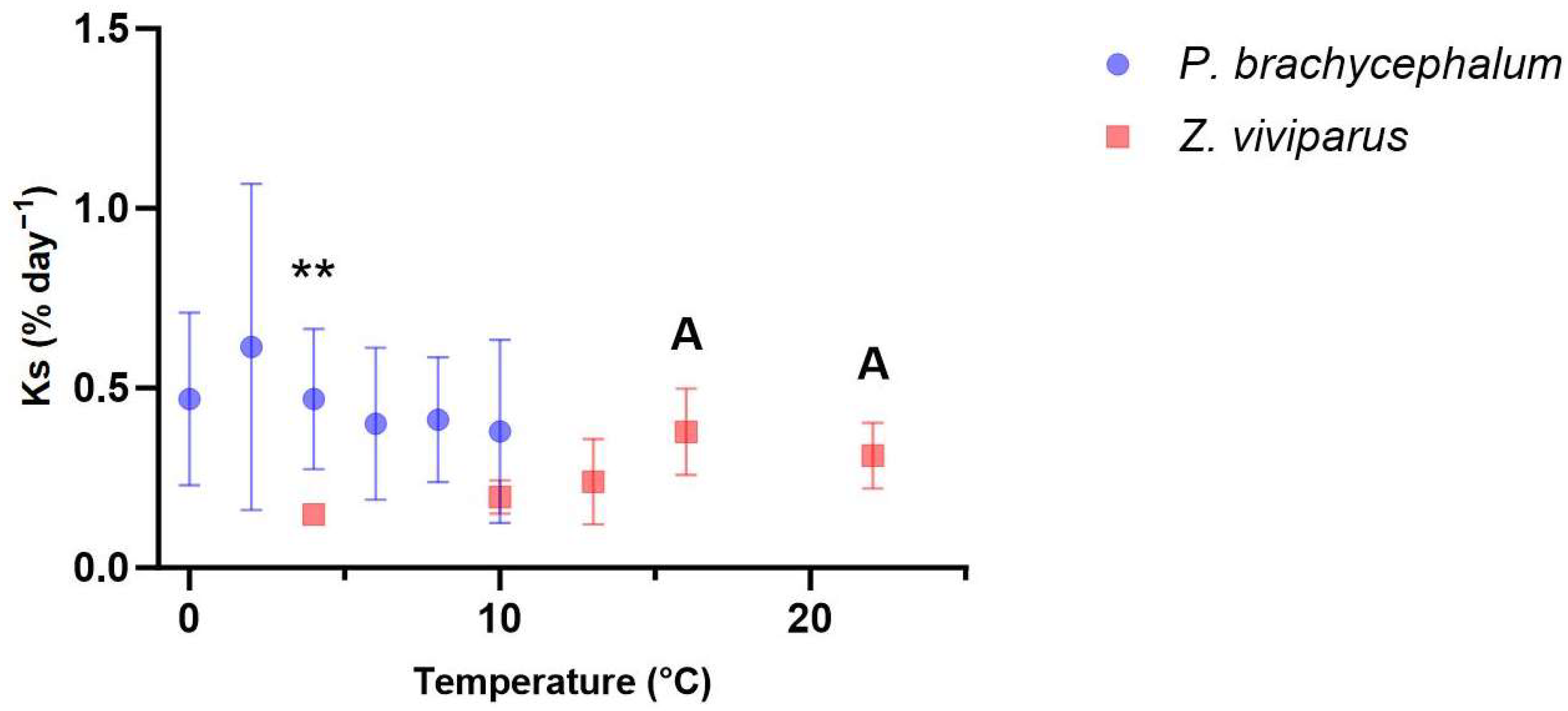
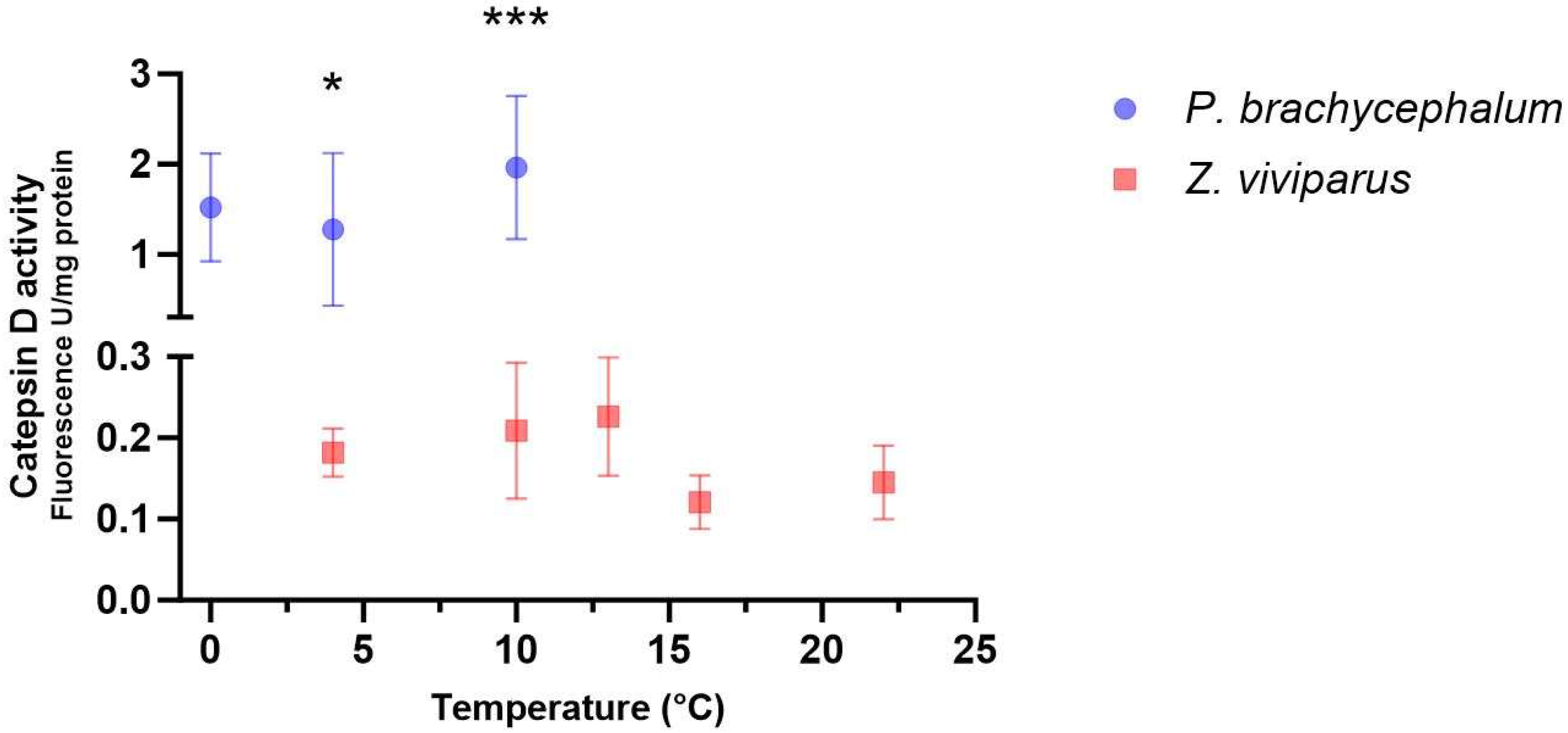
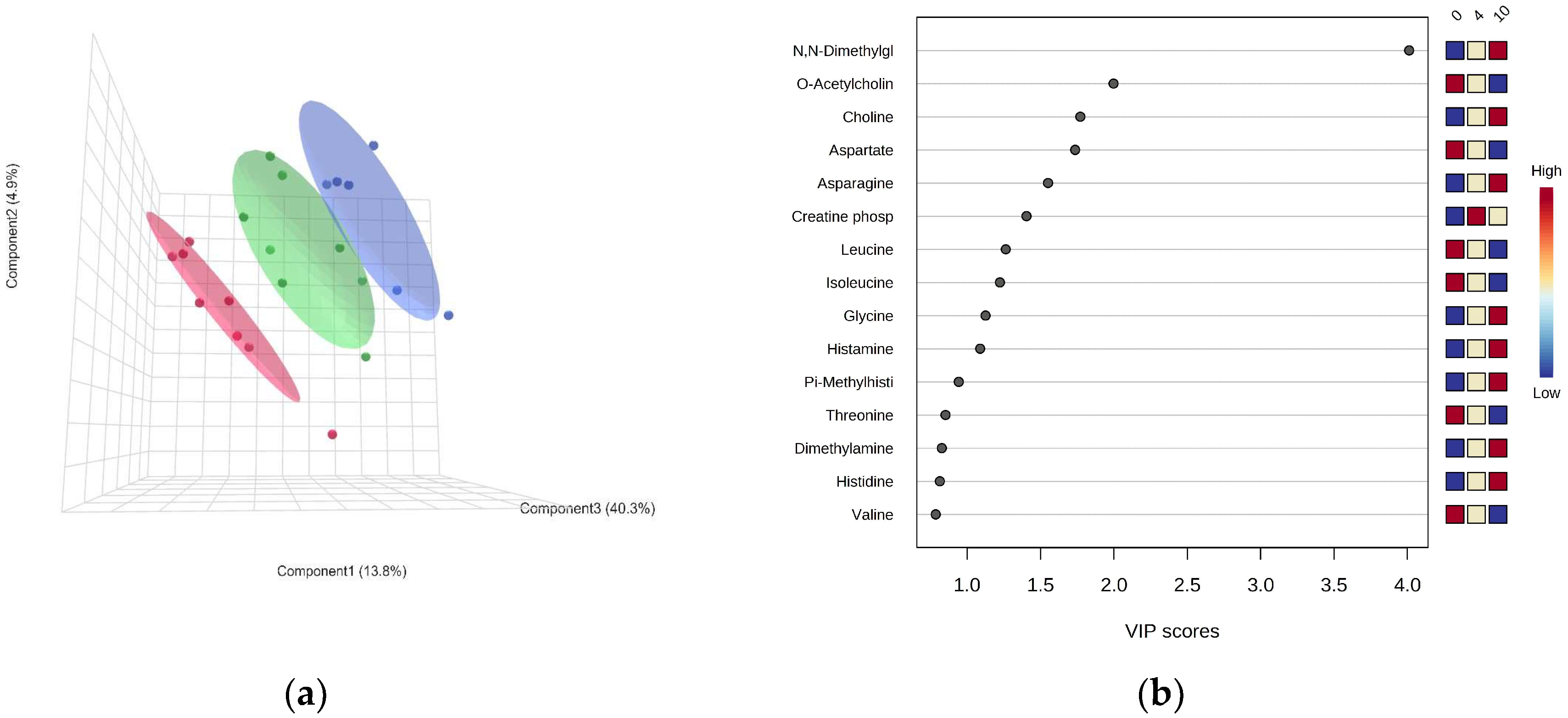
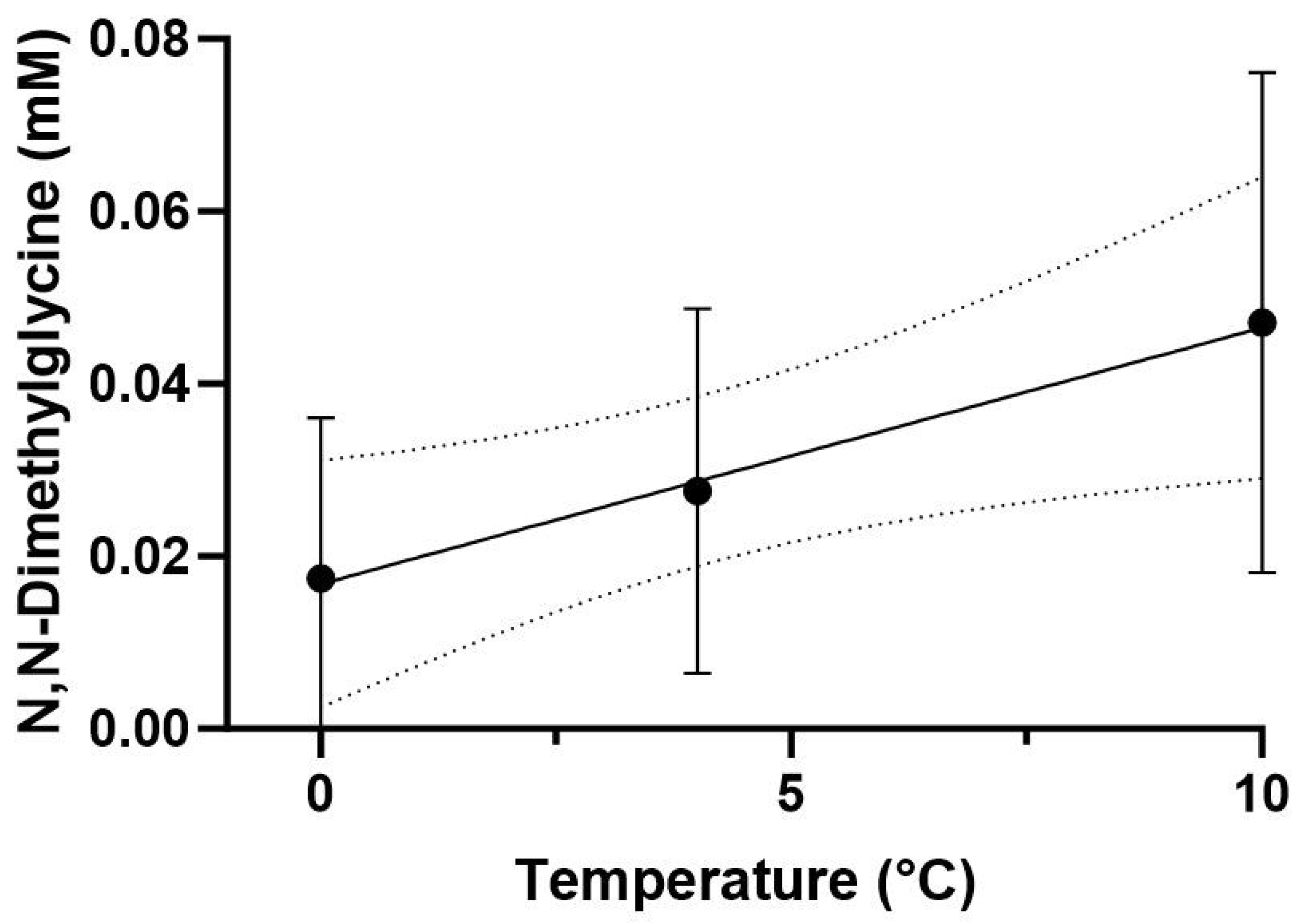
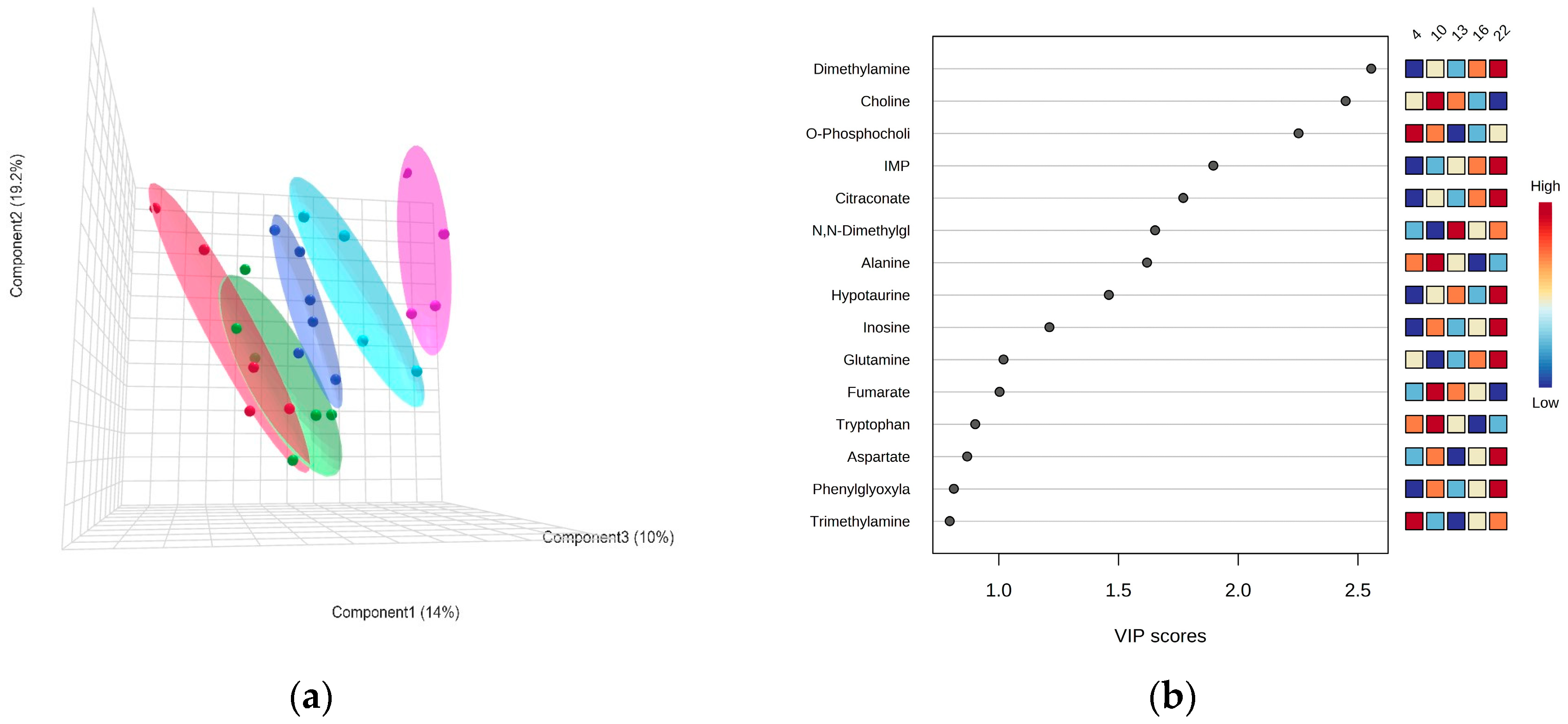
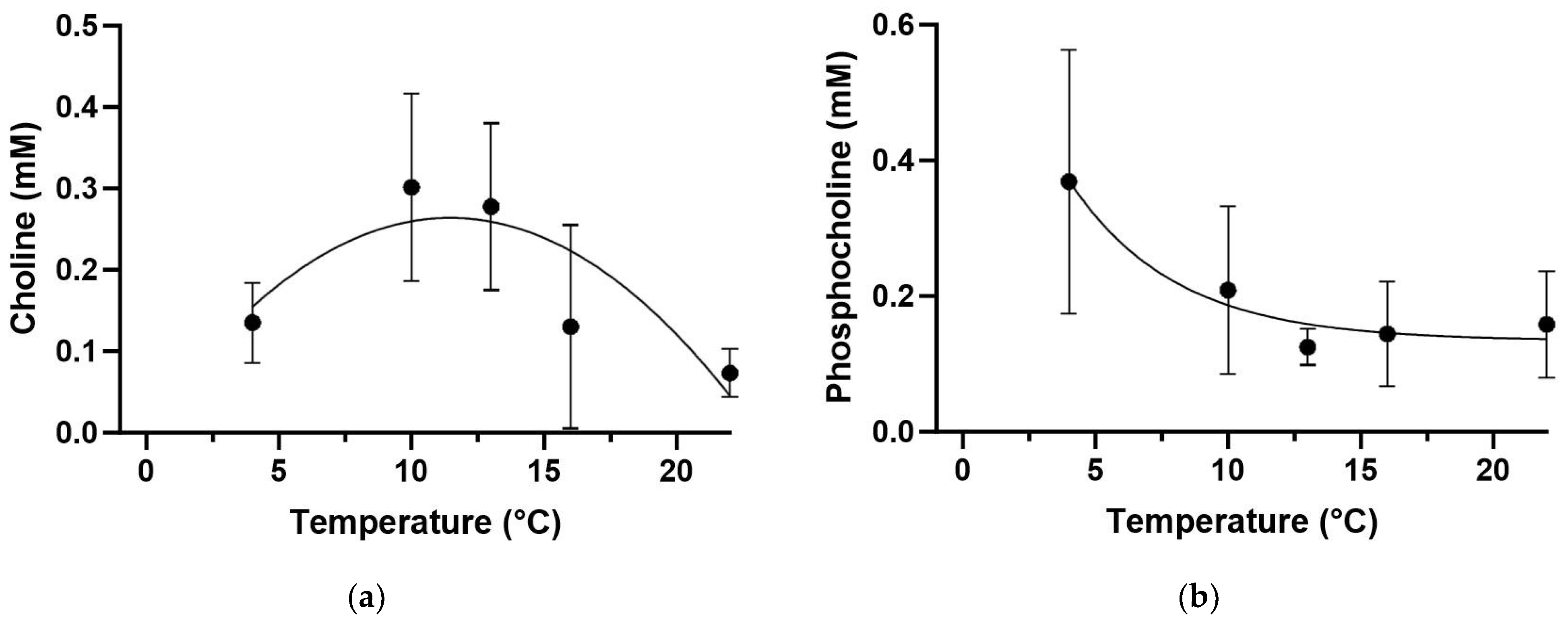
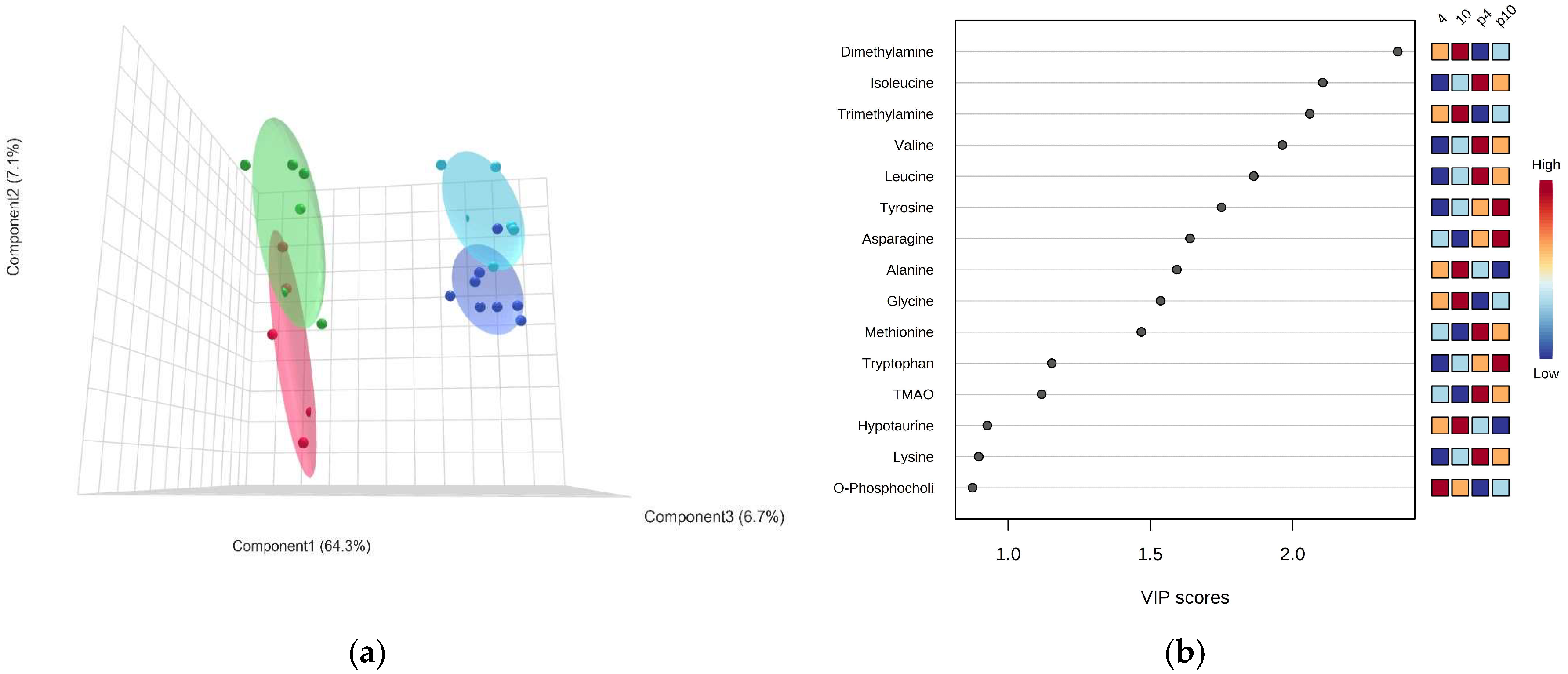
| Metabolite (Name) | Concentration in Z. viviparus (mM) | Concentration in P. brachycephalum (mM) | Fold Difference of Means between PB and ZV |
|---|---|---|---|
| Amino acids | |||
| Isoleucine | 0.08 ± 0.04 | 0.69 ± 0.34 | 9.1 |
| Valine | 0.14 ± 0.07 | 1.11 ± 0.55 | 8 |
| Leucine | 0.12 ± 0.05 | 0.90 ± 0.43 | 7.2 |
| Asparagine | 0.11 ± 0.06 | 0.56 ± 0.20 | 5.6 |
| Methionine | 0.07 ± 0.03 | 0.31 ± 0.14 | 4.6 |
| Tryptophan | 0.03 ± 0.01 | 0.11 ± 0.04 | 3.4 |
| Lysine | 0.67 ± 0.26 | 1.62 ± 0.59 | 2.4 |
| Glycine | 14.59 ± 5.43 | 2.43 ± 0.78 | 0.17 |
| Alanine | 5.96 ± 1.30 | 1.11 ± 0.34 | 0.19 |
| Histidine | 0.86 ± 0.32 | 0.38 ± 0.14 | 0.44 |
| Methylamine | |||
| TMAO | 7.54 ± 4.62 | 23.15 ± 3.49 | 3.1 |
| Dimethylamine | 1.93 ± 1.32 | 0.09 ± 0.05 | 0.05 |
| Trimethylamine | 0.21 ± 0.13 | 0.014 ± 0.003 | 0.07 |
| Others | |||
| Hypotaurine | 0.002 ± 0.001 | 0.0007 ± 0.0003 | 0.35 |
| Taurine | 8.96 ± 2.42 | 3.94 ± 0.92 | 0.44 |
Disclaimer/Publisher’s Note: The statements, opinions and data contained in all publications are solely those of the individual author(s) and contributor(s) and not of MDPI and/or the editor(s). MDPI and/or the editor(s) disclaim responsibility for any injury to people or property resulting from any ideas, methods, instructions or products referred to in the content. |
© 2023 by the authors. Licensee MDPI, Basel, Switzerland. This article is an open access article distributed under the terms and conditions of the Creative Commons Attribution (CC BY) license (https://creativecommons.org/licenses/by/4.0/).
Share and Cite
Krebs, N.; Bock, C.; Tebben, J.; Mark, F.C.; Lucassen, M.; Lannig, G.; Pörtner, H.-O. Evolutionary Adaptation of Protein Turnover in White Muscle of Stenothermal Antarctic Fish: Elevated Cold Compensation at Reduced Thermal Responsiveness. Biomolecules 2023, 13, 1507. https://doi.org/10.3390/biom13101507
Krebs N, Bock C, Tebben J, Mark FC, Lucassen M, Lannig G, Pörtner H-O. Evolutionary Adaptation of Protein Turnover in White Muscle of Stenothermal Antarctic Fish: Elevated Cold Compensation at Reduced Thermal Responsiveness. Biomolecules. 2023; 13(10):1507. https://doi.org/10.3390/biom13101507
Chicago/Turabian StyleKrebs, Nina, Christian Bock, Jan Tebben, Felix C. Mark, Magnus Lucassen, Gisela Lannig, and Hans-Otto Pörtner. 2023. "Evolutionary Adaptation of Protein Turnover in White Muscle of Stenothermal Antarctic Fish: Elevated Cold Compensation at Reduced Thermal Responsiveness" Biomolecules 13, no. 10: 1507. https://doi.org/10.3390/biom13101507
APA StyleKrebs, N., Bock, C., Tebben, J., Mark, F. C., Lucassen, M., Lannig, G., & Pörtner, H.-O. (2023). Evolutionary Adaptation of Protein Turnover in White Muscle of Stenothermal Antarctic Fish: Elevated Cold Compensation at Reduced Thermal Responsiveness. Biomolecules, 13(10), 1507. https://doi.org/10.3390/biom13101507








